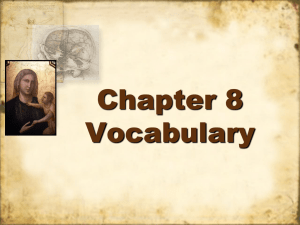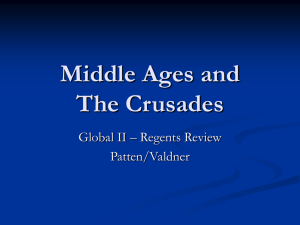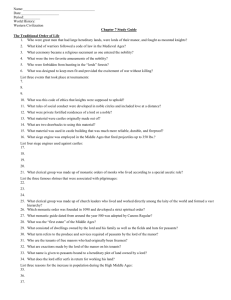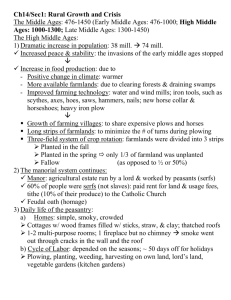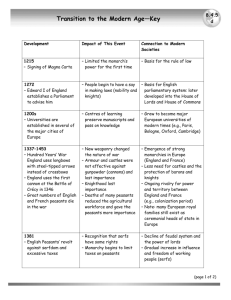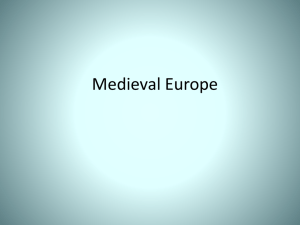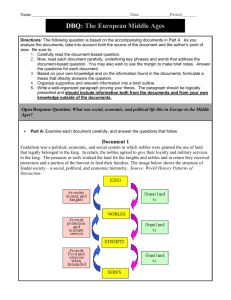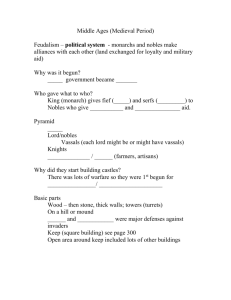Section 3 - Peasants_ Trade_ and Cities
advertisement
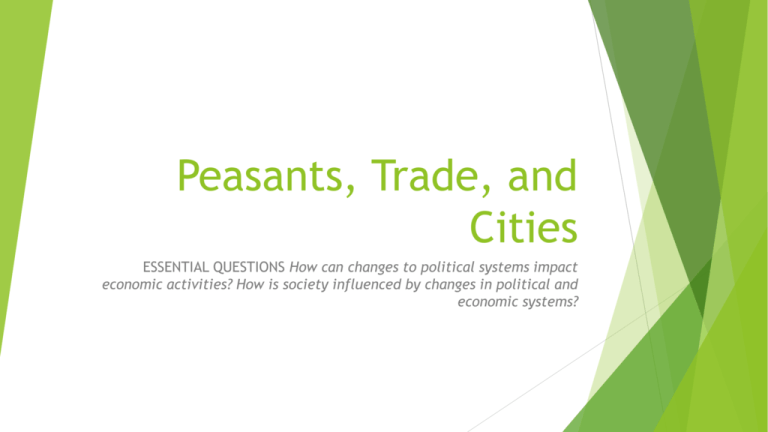
Peasants, Trade, and Cities ESSENTIAL QUESTIONS How can changes to political systems impact economic activities? How is society influenced by changes in political and economic systems? The New Agriculture Guiding Question - How did new farming methods benefit Europe in the Middle Ages? In the Early Middle Ages to the High Middle Ages population in Europe doubled between 1000 and 1300 from approximately 38 million to 74 million people. What caused this huge increase? • Europe was more settled and peaceful after the invasions of the Early Middle Ages had stopped. • Food production after 1000 also increased because the climate changed during the High Middle Ages, resulting in improved growing conditions. Technological Advances Changes in technology also aided the growth of farming. • explosion of labor-saving devices. • harnessed the power of water and wind to do jobs once done by human or animal power. • Many of these new devices were made from iron • carruca, a heavy, wheeled plow with an iron plowshare. • this plow, drawn by six or eight oxen, easily turned over heavy clay soils. • led to the growth of farming villages, • where people worked together. Because iron was expensive, an entire community had to buy a carruca. • one family could not afford a team of animals, so villagers shared their beasts. Shifting from a two-field to a three-field crop rotation also increased food production. • Earlier peasants divided their land into two fields. • planted one field and allowed the other to lie fallow, or unplanted, to regain its fertility. • Now, lands were divided into three parts. • Peasants planted one field in the fall with grains, such as rye and wheat, that they harvested in summer. • They planted the second field in spring with grains, such as oats and barley, and vegetables, such as peas and beans, that they harvested in fall. • They allowed the third field to lie fallow. • This way, only one-third, rather than one-half, of the land lay fallow at any time. • This practice of rotating crops kept the soil fertile, while allowing people to grow more crops. Recap: What factors led to population growth in the High Middle Ages? The Manorial System Guiding Question: What was life like for nobles and peasants under the economic system of manorialism? A manor was an agricultural estate that a lord ran and peasants worked. • free peasants continued to exist, increasing numbers of free peasants became serfs, or peasants legally bound to the land. • Serfs had to give labor services, pay rents, and be subject to the lord's control. • By 800, probably 60 percent of western Europeans were serfs. Serf - in medieval Europe, a peasant legally bound to the land who had to provide labor services, pay rents, and be subject to the lord’s control A serf's labor services included working the lord's land, which made up one-third to one-half of the cultivated land scattered throughout the manor. • Peasants used the rest of the estate's land to grow food for themselves. • Serfs usually worked about three days a week for their lords and paid rents by giving the lords a share of every product they raised. • Serfs also paid the lords for the use of the manor's common pasturelands, streams, ponds, and woodlands. Lords had a variety of legal rights over the serfs on their estates. • Serfs could not leave the manor without the lord's permission. • Lords often had political authority on their lands, which gave them the right to try peasants in their own courts. However – • The land assigned to serfs to support themselves usually could not be taken away • their responsibilities to the lord remained fairly fixed. • It was also the lord's duty to protect his serfs, giving them the safety to farm the land. The life of peasants in Europe was simple. • cottages had wood frames surrounded by sticks, with the spaces between sticks filled with straw and rubble and then plastered over with clay. • Roofs were simply thatched. • houses of poorer peasants consisted of a single room. • Others had at least two rooms—a main room for cooking, eating, and other activities and another room for sleeping. • There was little privacy in a medieval household. The seasons of the year largely determined peasant activities. • Harvest time in August and September was especially hectic. • good harvest of grains for making bread was crucial to survival in the winter months. • new cycle of labor began in October, when peasants worked the ground for the planting of winter crops. • November came the slaughter of excess livestock because there was usually not enough food to keep the animals alive all winter. • meat would be salted to preserve it for winter use. • February and March, the land was plowed for the planting of spring crops—oats, barley, peas, and beans. • Early summer was a fairly relaxed time, although there was still weeding and sheepshearing to be done. The Revival of Trade Guiding Question: How did the revival of trade result in a commercial revolution during the Middle Ages? 1000s and 1100s, however, Europe experienced a revival of trade and an associated growth of towns and cities. • revival of trade in Europe was gradual. • In the thirteenth century a medieval trade association, the Hanseatic League, developed in the Baltic and North Sea region. • The Hanseatic League was an alliance of more than 100 northern European cities that banded together for mutual trade protection and economic opportunity. • Northern European merchants brought furs, woolen cloth, tin, hemp, and honey to trade for cloth and swords from northern Italy and the silks, sugar, and spices of the East. • As trade increased, so did the demand for gold and silver coins. • Slowly, a money economy—an economic system based on money rather than barter— emerged. • New trading companies and banking firms were set up to manage the exchange and sale of goods. These new practices were part of the rise of commercial capitalism, an economic system in which people invested in trade and goods for profit. The Growth of Cities Guiding Question: What spurred the growth of cities in the Middle Ages? The revival of trade led to a revival of cities. • With the revival of trade, merchants began to settle in the old Roman cities. • followed by craftspeople or artisans—people who had developed skills and saw a chance to make goods that the merchants could sell. Many new cities or towns were also founded, especially in northern Europe. • Usually a group of merchants built a settlement near a castle because it was located along a trade route or river and because the lords of the castle would offer protection. • If the settlement prospered and expanded, new walls were built to protect it. The merchants and artisans of these new cities later came to be called burghers, or bourgeoisie. • meaning "a walled enclosure." • Medieval cities were small in comparison with either ancient cities or modern cities. • A large medieval trading city would have about 5,000 inhabitants. Most towns were often part of a lord's territory and were therefore subject to his authority. • townspeople needed freedom to trade. • wanted their own unique laws and were willing to pay for them. • Lords and kings, in turn, saw that they could also make money and sold to the townspeople the liberties they wanted. By 1100, townspeople had numerous rights from local lords. • right to buy and sell property • freedom from military service to the lord • a written law that guaranteed townspeople their freedom • right for an escaped serf to become a free person after living a year and a day in the town. Patricians - members of the wealthiest and most powerful families—were elected to public office Medieval Cities Medieval cities were surrounded by stone walls. • Walls were expensive to build, so the cities were tightly filled. • had narrow, winding streets, and houses were crowded against one another, with the second and third stories built out over the streets. The physical environment of medieval cities was not pleasant. • dirty, cities smelled from animal and human waste. • Air pollution was also a fact of life. • Smoke from wood fires or from the burning of cheap grades of coal filled the air. • Women were expected to supervise the household, prepare meals, raise the children, and manage the family's finances. • they helped their husbands in their trades, and some women developed their own trades to earn extra money. • was thus possible for women in medieval towns to lead quite independent lives. Let’s review How did new farming methods benefit Europe in the Middle Ages? What was life like for nobles and peasants under the economic system of manorialism? What factors led to population growth in the High Ages? How were serfs legally bound to the land? What spurred the growth of cities in the Middle Ages?
